Human Resource Planning: An Analysis of LIDL's Strategies
VerifiedAdded on 2022/09/01
|18
|4722
|26
Report
AI Summary
This report provides a comprehensive analysis of LIDL's human resource planning, examining various aspects crucial for the company's success. It begins with an executive summary and table of contents, followed by an introduction to human resource planning and its importance in organizations like LIDL. The report delves into the HR planning methods employed by LIDL, analyzing its current strategic plan and the existing internal and external factors influencing its operations. It also covers forecasting future demand and supply, the action plan for implementation, and the recruitment and selection processes, including the importance of job analysis and various sources of recruitment. Furthermore, the report explores learning and development initiatives, performance management strategies, and the link between performance management and strategic rewards. The conclusion summarizes the key findings and recommendations, supported by references to relevant sources. This report offers valuable insights into the HR practices of LIDL and provides a framework for understanding how these practices contribute to its competitive advantage.
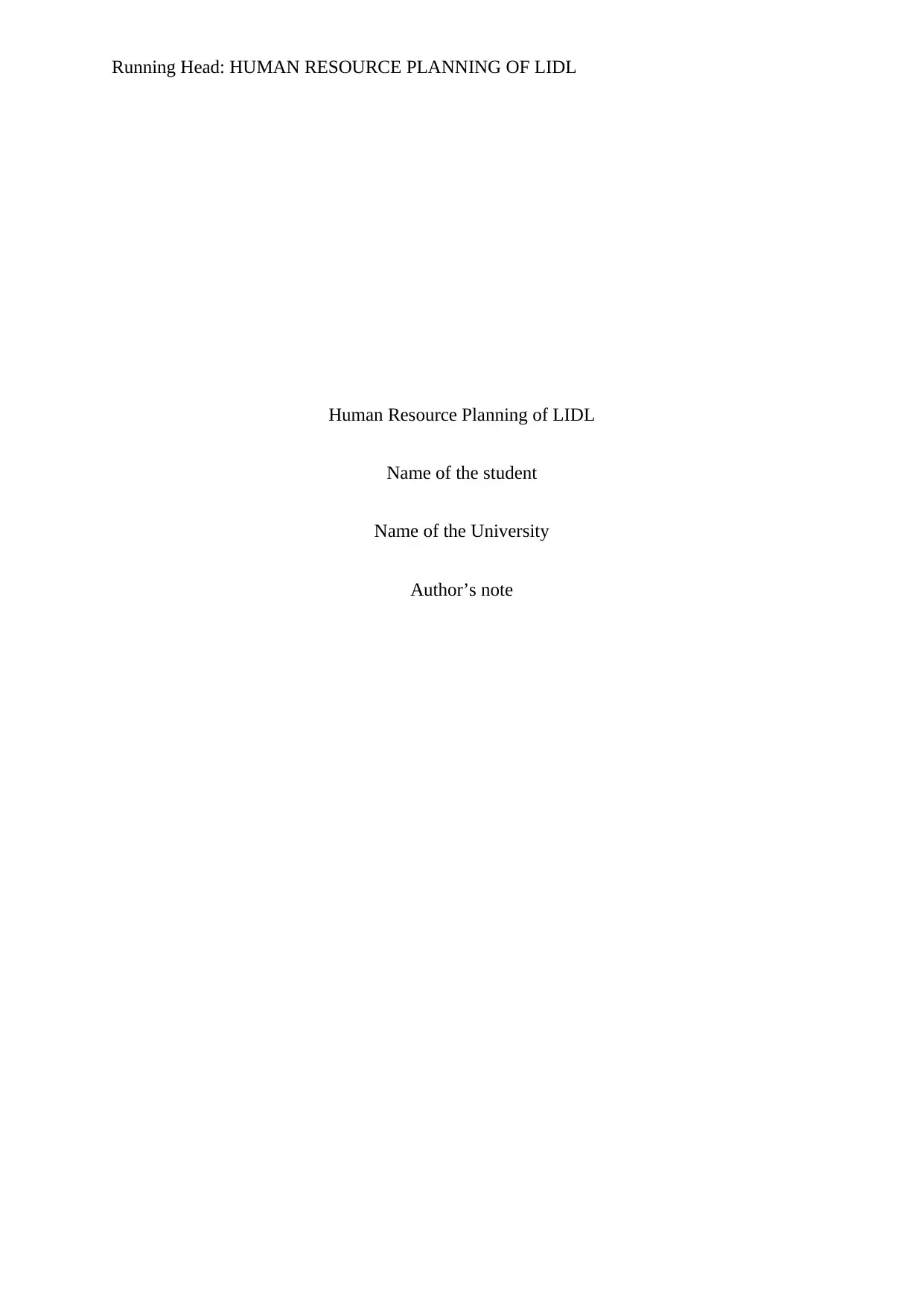
Running Head: HUMAN RESOURCE PLANNING OF LIDL
Human Resource Planning of LIDL
Name of the student
Name of the University
Author’s note
Human Resource Planning of LIDL
Name of the student
Name of the University
Author’s note
Paraphrase This Document
Need a fresh take? Get an instant paraphrase of this document with our AI Paraphraser
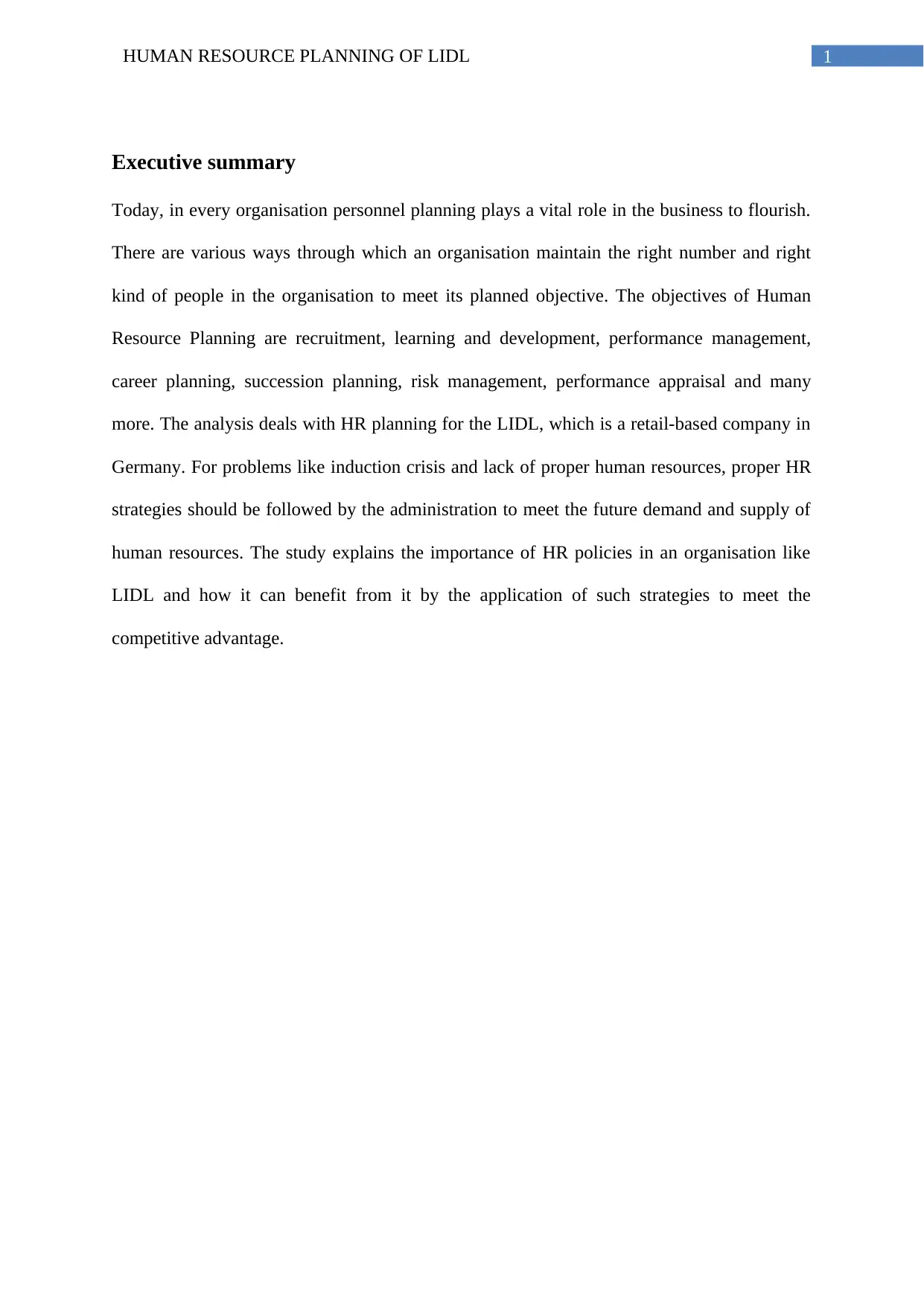
1HUMAN RESOURCE PLANNING OF LIDL
Executive summary
Today, in every organisation personnel planning plays a vital role in the business to flourish.
There are various ways through which an organisation maintain the right number and right
kind of people in the organisation to meet its planned objective. The objectives of Human
Resource Planning are recruitment, learning and development, performance management,
career planning, succession planning, risk management, performance appraisal and many
more. The analysis deals with HR planning for the LIDL, which is a retail-based company in
Germany. For problems like induction crisis and lack of proper human resources, proper HR
strategies should be followed by the administration to meet the future demand and supply of
human resources. The study explains the importance of HR policies in an organisation like
LIDL and how it can benefit from it by the application of such strategies to meet the
competitive advantage.
Executive summary
Today, in every organisation personnel planning plays a vital role in the business to flourish.
There are various ways through which an organisation maintain the right number and right
kind of people in the organisation to meet its planned objective. The objectives of Human
Resource Planning are recruitment, learning and development, performance management,
career planning, succession planning, risk management, performance appraisal and many
more. The analysis deals with HR planning for the LIDL, which is a retail-based company in
Germany. For problems like induction crisis and lack of proper human resources, proper HR
strategies should be followed by the administration to meet the future demand and supply of
human resources. The study explains the importance of HR policies in an organisation like
LIDL and how it can benefit from it by the application of such strategies to meet the
competitive advantage.
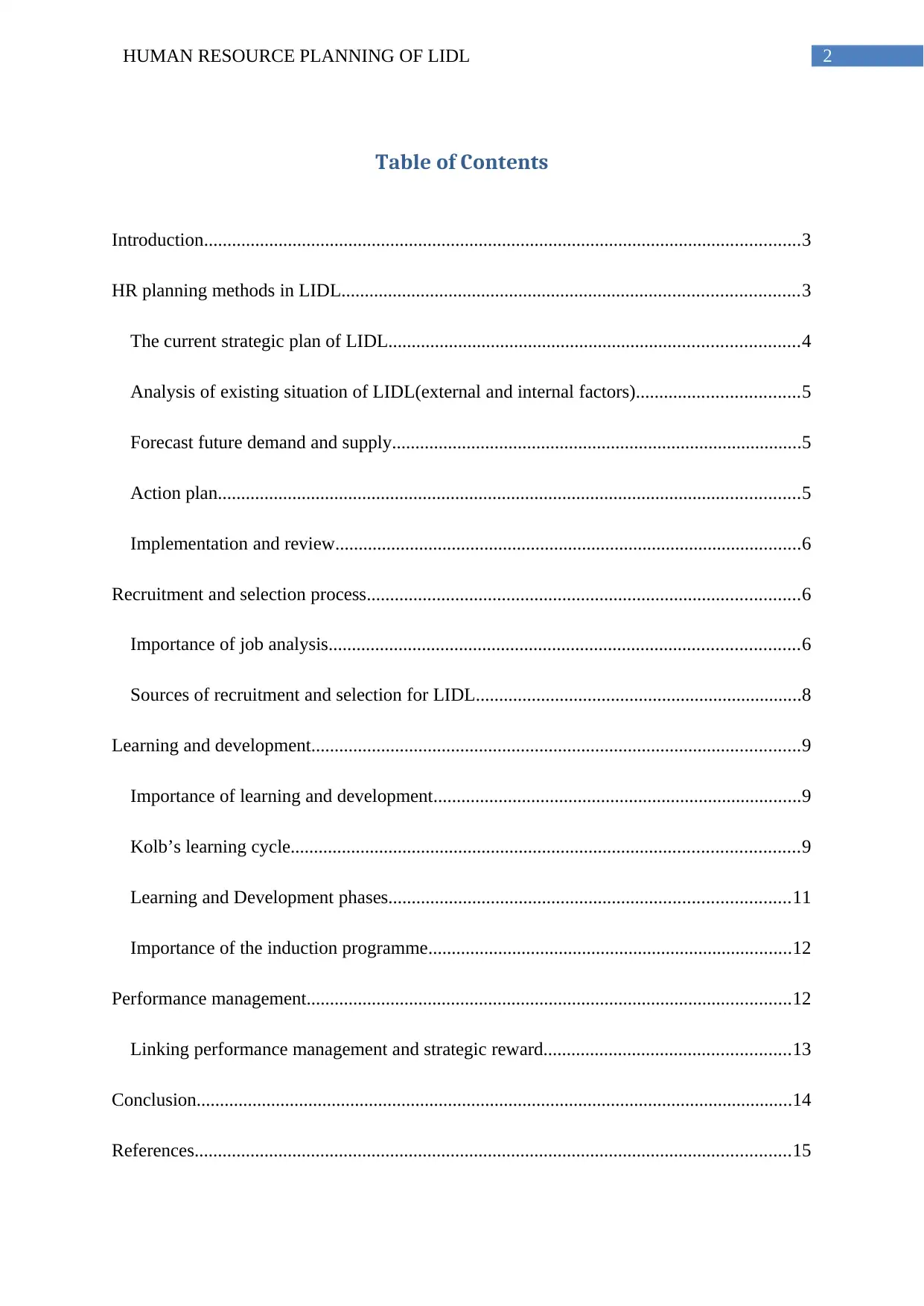
2HUMAN RESOURCE PLANNING OF LIDL
Table of Contents
Introduction................................................................................................................................3
HR planning methods in LIDL..................................................................................................3
The current strategic plan of LIDL........................................................................................4
Analysis of existing situation of LIDL(external and internal factors)...................................5
Forecast future demand and supply........................................................................................5
Action plan.............................................................................................................................5
Implementation and review....................................................................................................6
Recruitment and selection process.............................................................................................6
Importance of job analysis.....................................................................................................6
Sources of recruitment and selection for LIDL......................................................................8
Learning and development.........................................................................................................9
Importance of learning and development...............................................................................9
Kolb’s learning cycle.............................................................................................................9
Learning and Development phases......................................................................................11
Importance of the induction programme..............................................................................12
Performance management........................................................................................................12
Linking performance management and strategic reward.....................................................13
Conclusion................................................................................................................................14
References................................................................................................................................15
Table of Contents
Introduction................................................................................................................................3
HR planning methods in LIDL..................................................................................................3
The current strategic plan of LIDL........................................................................................4
Analysis of existing situation of LIDL(external and internal factors)...................................5
Forecast future demand and supply........................................................................................5
Action plan.............................................................................................................................5
Implementation and review....................................................................................................6
Recruitment and selection process.............................................................................................6
Importance of job analysis.....................................................................................................6
Sources of recruitment and selection for LIDL......................................................................8
Learning and development.........................................................................................................9
Importance of learning and development...............................................................................9
Kolb’s learning cycle.............................................................................................................9
Learning and Development phases......................................................................................11
Importance of the induction programme..............................................................................12
Performance management........................................................................................................12
Linking performance management and strategic reward.....................................................13
Conclusion................................................................................................................................14
References................................................................................................................................15
⊘ This is a preview!⊘
Do you want full access?
Subscribe today to unlock all pages.

Trusted by 1+ million students worldwide
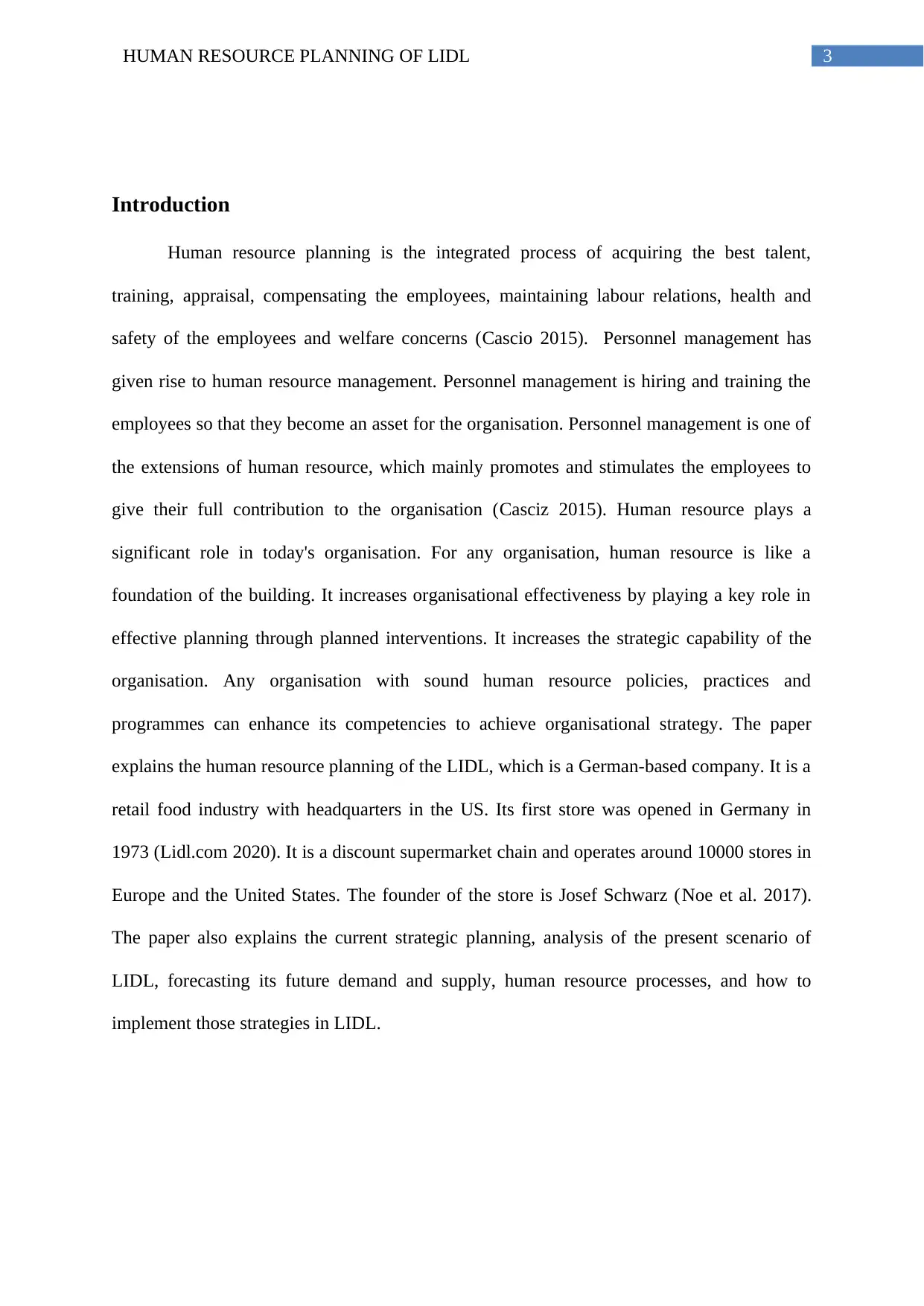
3HUMAN RESOURCE PLANNING OF LIDL
Introduction
Human resource planning is the integrated process of acquiring the best talent,
training, appraisal, compensating the employees, maintaining labour relations, health and
safety of the employees and welfare concerns (Cascio 2015). Personnel management has
given rise to human resource management. Personnel management is hiring and training the
employees so that they become an asset for the organisation. Personnel management is one of
the extensions of human resource, which mainly promotes and stimulates the employees to
give their full contribution to the organisation (Casciz 2015). Human resource plays a
significant role in today's organisation. For any organisation, human resource is like a
foundation of the building. It increases organisational effectiveness by playing a key role in
effective planning through planned interventions. It increases the strategic capability of the
organisation. Any organisation with sound human resource policies, practices and
programmes can enhance its competencies to achieve organisational strategy. The paper
explains the human resource planning of the LIDL, which is a German-based company. It is a
retail food industry with headquarters in the US. Its first store was opened in Germany in
1973 (Lidl.com 2020). It is a discount supermarket chain and operates around 10000 stores in
Europe and the United States. The founder of the store is Josef Schwarz (Noe et al. 2017).
The paper also explains the current strategic planning, analysis of the present scenario of
LIDL, forecasting its future demand and supply, human resource processes, and how to
implement those strategies in LIDL.
Introduction
Human resource planning is the integrated process of acquiring the best talent,
training, appraisal, compensating the employees, maintaining labour relations, health and
safety of the employees and welfare concerns (Cascio 2015). Personnel management has
given rise to human resource management. Personnel management is hiring and training the
employees so that they become an asset for the organisation. Personnel management is one of
the extensions of human resource, which mainly promotes and stimulates the employees to
give their full contribution to the organisation (Casciz 2015). Human resource plays a
significant role in today's organisation. For any organisation, human resource is like a
foundation of the building. It increases organisational effectiveness by playing a key role in
effective planning through planned interventions. It increases the strategic capability of the
organisation. Any organisation with sound human resource policies, practices and
programmes can enhance its competencies to achieve organisational strategy. The paper
explains the human resource planning of the LIDL, which is a German-based company. It is a
retail food industry with headquarters in the US. Its first store was opened in Germany in
1973 (Lidl.com 2020). It is a discount supermarket chain and operates around 10000 stores in
Europe and the United States. The founder of the store is Josef Schwarz (Noe et al. 2017).
The paper also explains the current strategic planning, analysis of the present scenario of
LIDL, forecasting its future demand and supply, human resource processes, and how to
implement those strategies in LIDL.
Paraphrase This Document
Need a fresh take? Get an instant paraphrase of this document with our AI Paraphraser
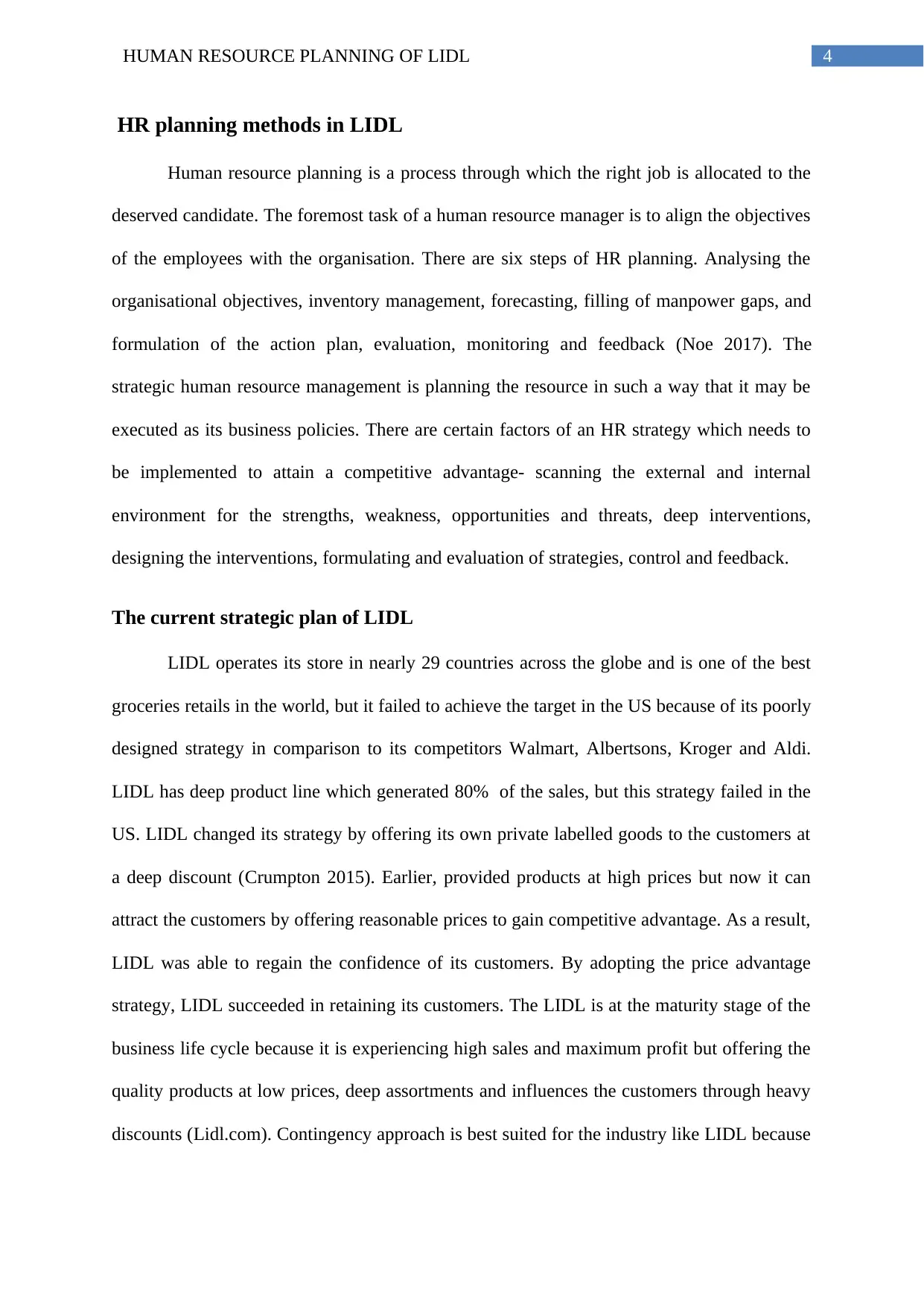
4HUMAN RESOURCE PLANNING OF LIDL
HR planning methods in LIDL
Human resource planning is a process through which the right job is allocated to the
deserved candidate. The foremost task of a human resource manager is to align the objectives
of the employees with the organisation. There are six steps of HR planning. Analysing the
organisational objectives, inventory management, forecasting, filling of manpower gaps, and
formulation of the action plan, evaluation, monitoring and feedback (Noe 2017). The
strategic human resource management is planning the resource in such a way that it may be
executed as its business policies. There are certain factors of an HR strategy which needs to
be implemented to attain a competitive advantage- scanning the external and internal
environment for the strengths, weakness, opportunities and threats, deep interventions,
designing the interventions, formulating and evaluation of strategies, control and feedback.
The current strategic plan of LIDL
LIDL operates its store in nearly 29 countries across the globe and is one of the best
groceries retails in the world, but it failed to achieve the target in the US because of its poorly
designed strategy in comparison to its competitors Walmart, Albertsons, Kroger and Aldi.
LIDL has deep product line which generated 80% of the sales, but this strategy failed in the
US. LIDL changed its strategy by offering its own private labelled goods to the customers at
a deep discount (Crumpton 2015). Earlier, provided products at high prices but now it can
attract the customers by offering reasonable prices to gain competitive advantage. As a result,
LIDL was able to regain the confidence of its customers. By adopting the price advantage
strategy, LIDL succeeded in retaining its customers. The LIDL is at the maturity stage of the
business life cycle because it is experiencing high sales and maximum profit but offering the
quality products at low prices, deep assortments and influences the customers through heavy
discounts (Lidl.com). Contingency approach is best suited for the industry like LIDL because
HR planning methods in LIDL
Human resource planning is a process through which the right job is allocated to the
deserved candidate. The foremost task of a human resource manager is to align the objectives
of the employees with the organisation. There are six steps of HR planning. Analysing the
organisational objectives, inventory management, forecasting, filling of manpower gaps, and
formulation of the action plan, evaluation, monitoring and feedback (Noe 2017). The
strategic human resource management is planning the resource in such a way that it may be
executed as its business policies. There are certain factors of an HR strategy which needs to
be implemented to attain a competitive advantage- scanning the external and internal
environment for the strengths, weakness, opportunities and threats, deep interventions,
designing the interventions, formulating and evaluation of strategies, control and feedback.
The current strategic plan of LIDL
LIDL operates its store in nearly 29 countries across the globe and is one of the best
groceries retails in the world, but it failed to achieve the target in the US because of its poorly
designed strategy in comparison to its competitors Walmart, Albertsons, Kroger and Aldi.
LIDL has deep product line which generated 80% of the sales, but this strategy failed in the
US. LIDL changed its strategy by offering its own private labelled goods to the customers at
a deep discount (Crumpton 2015). Earlier, provided products at high prices but now it can
attract the customers by offering reasonable prices to gain competitive advantage. As a result,
LIDL was able to regain the confidence of its customers. By adopting the price advantage
strategy, LIDL succeeded in retaining its customers. The LIDL is at the maturity stage of the
business life cycle because it is experiencing high sales and maximum profit but offering the
quality products at low prices, deep assortments and influences the customers through heavy
discounts (Lidl.com). Contingency approach is best suited for the industry like LIDL because
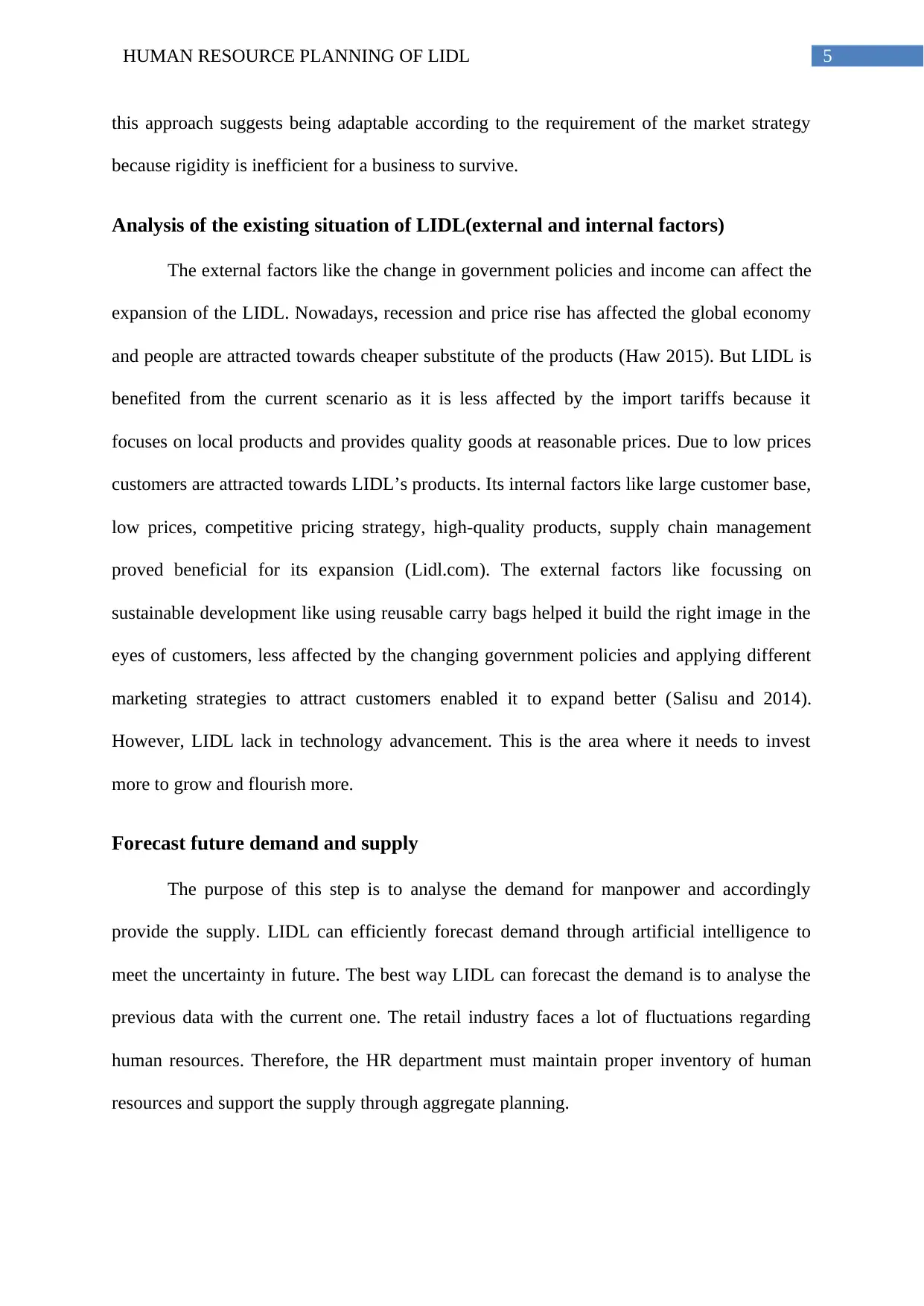
5HUMAN RESOURCE PLANNING OF LIDL
this approach suggests being adaptable according to the requirement of the market strategy
because rigidity is inefficient for a business to survive.
Analysis of the existing situation of LIDL(external and internal factors)
The external factors like the change in government policies and income can affect the
expansion of the LIDL. Nowadays, recession and price rise has affected the global economy
and people are attracted towards cheaper substitute of the products (Haw 2015). But LIDL is
benefited from the current scenario as it is less affected by the import tariffs because it
focuses on local products and provides quality goods at reasonable prices. Due to low prices
customers are attracted towards LIDL’s products. Its internal factors like large customer base,
low prices, competitive pricing strategy, high-quality products, supply chain management
proved beneficial for its expansion (Lidl.com). The external factors like focussing on
sustainable development like using reusable carry bags helped it build the right image in the
eyes of customers, less affected by the changing government policies and applying different
marketing strategies to attract customers enabled it to expand better (Salisu and 2014).
However, LIDL lack in technology advancement. This is the area where it needs to invest
more to grow and flourish more.
Forecast future demand and supply
The purpose of this step is to analyse the demand for manpower and accordingly
provide the supply. LIDL can efficiently forecast demand through artificial intelligence to
meet the uncertainty in future. The best way LIDL can forecast the demand is to analyse the
previous data with the current one. The retail industry faces a lot of fluctuations regarding
human resources. Therefore, the HR department must maintain proper inventory of human
resources and support the supply through aggregate planning.
this approach suggests being adaptable according to the requirement of the market strategy
because rigidity is inefficient for a business to survive.
Analysis of the existing situation of LIDL(external and internal factors)
The external factors like the change in government policies and income can affect the
expansion of the LIDL. Nowadays, recession and price rise has affected the global economy
and people are attracted towards cheaper substitute of the products (Haw 2015). But LIDL is
benefited from the current scenario as it is less affected by the import tariffs because it
focuses on local products and provides quality goods at reasonable prices. Due to low prices
customers are attracted towards LIDL’s products. Its internal factors like large customer base,
low prices, competitive pricing strategy, high-quality products, supply chain management
proved beneficial for its expansion (Lidl.com). The external factors like focussing on
sustainable development like using reusable carry bags helped it build the right image in the
eyes of customers, less affected by the changing government policies and applying different
marketing strategies to attract customers enabled it to expand better (Salisu and 2014).
However, LIDL lack in technology advancement. This is the area where it needs to invest
more to grow and flourish more.
Forecast future demand and supply
The purpose of this step is to analyse the demand for manpower and accordingly
provide the supply. LIDL can efficiently forecast demand through artificial intelligence to
meet the uncertainty in future. The best way LIDL can forecast the demand is to analyse the
previous data with the current one. The retail industry faces a lot of fluctuations regarding
human resources. Therefore, the HR department must maintain proper inventory of human
resources and support the supply through aggregate planning.
⊘ This is a preview!⊘
Do you want full access?
Subscribe today to unlock all pages.

Trusted by 1+ million students worldwide
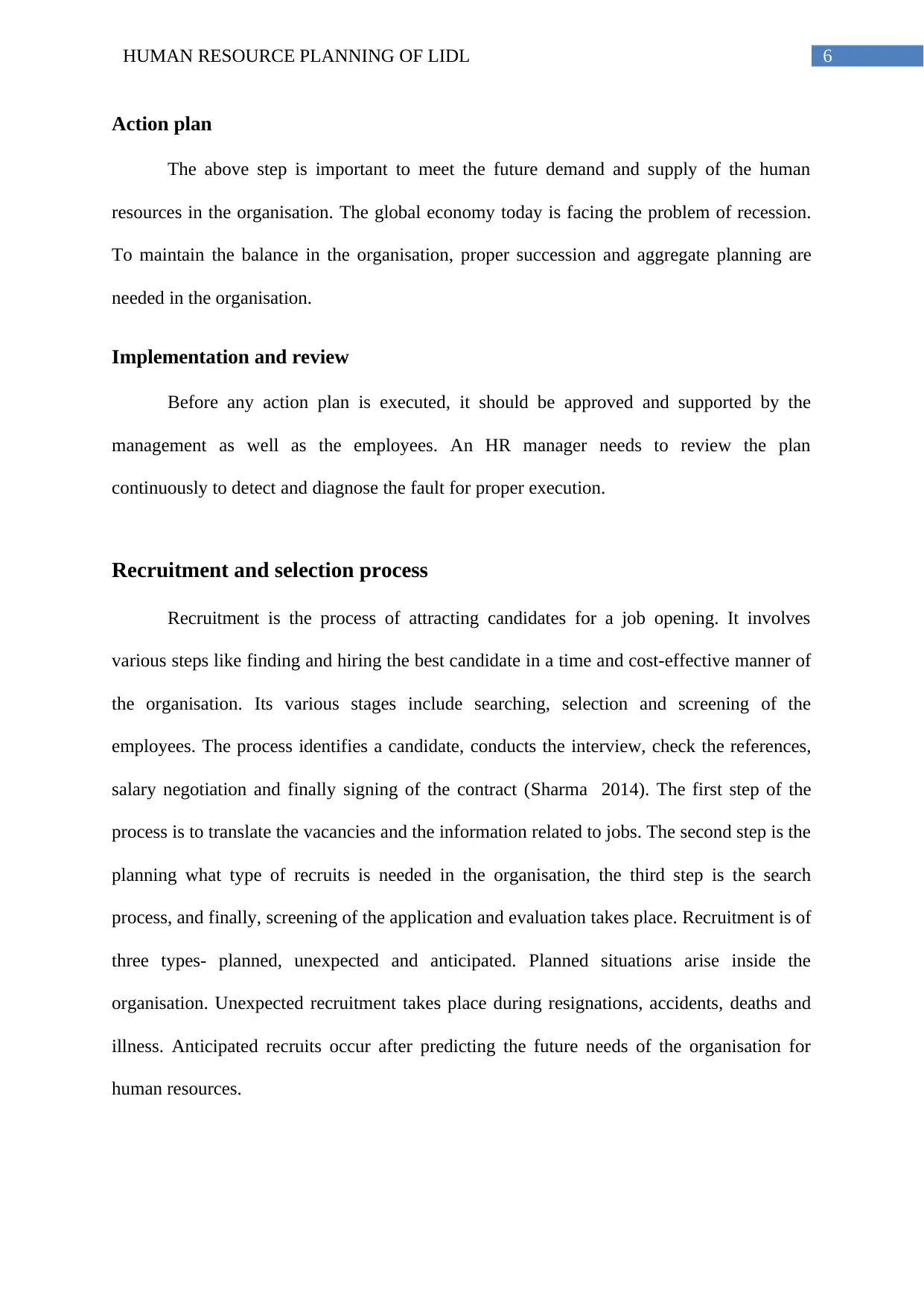
6HUMAN RESOURCE PLANNING OF LIDL
Action plan
The above step is important to meet the future demand and supply of the human
resources in the organisation. The global economy today is facing the problem of recession.
To maintain the balance in the organisation, proper succession and aggregate planning are
needed in the organisation.
Implementation and review
Before any action plan is executed, it should be approved and supported by the
management as well as the employees. An HR manager needs to review the plan
continuously to detect and diagnose the fault for proper execution.
Recruitment and selection process
Recruitment is the process of attracting candidates for a job opening. It involves
various steps like finding and hiring the best candidate in a time and cost-effective manner of
the organisation. Its various stages include searching, selection and screening of the
employees. The process identifies a candidate, conducts the interview, check the references,
salary negotiation and finally signing of the contract (Sharma 2014). The first step of the
process is to translate the vacancies and the information related to jobs. The second step is the
planning what type of recruits is needed in the organisation, the third step is the search
process, and finally, screening of the application and evaluation takes place. Recruitment is of
three types- planned, unexpected and anticipated. Planned situations arise inside the
organisation. Unexpected recruitment takes place during resignations, accidents, deaths and
illness. Anticipated recruits occur after predicting the future needs of the organisation for
human resources.
Action plan
The above step is important to meet the future demand and supply of the human
resources in the organisation. The global economy today is facing the problem of recession.
To maintain the balance in the organisation, proper succession and aggregate planning are
needed in the organisation.
Implementation and review
Before any action plan is executed, it should be approved and supported by the
management as well as the employees. An HR manager needs to review the plan
continuously to detect and diagnose the fault for proper execution.
Recruitment and selection process
Recruitment is the process of attracting candidates for a job opening. It involves
various steps like finding and hiring the best candidate in a time and cost-effective manner of
the organisation. Its various stages include searching, selection and screening of the
employees. The process identifies a candidate, conducts the interview, check the references,
salary negotiation and finally signing of the contract (Sharma 2014). The first step of the
process is to translate the vacancies and the information related to jobs. The second step is the
planning what type of recruits is needed in the organisation, the third step is the search
process, and finally, screening of the application and evaluation takes place. Recruitment is of
three types- planned, unexpected and anticipated. Planned situations arise inside the
organisation. Unexpected recruitment takes place during resignations, accidents, deaths and
illness. Anticipated recruits occur after predicting the future needs of the organisation for
human resources.
Paraphrase This Document
Need a fresh take? Get an instant paraphrase of this document with our AI Paraphraser
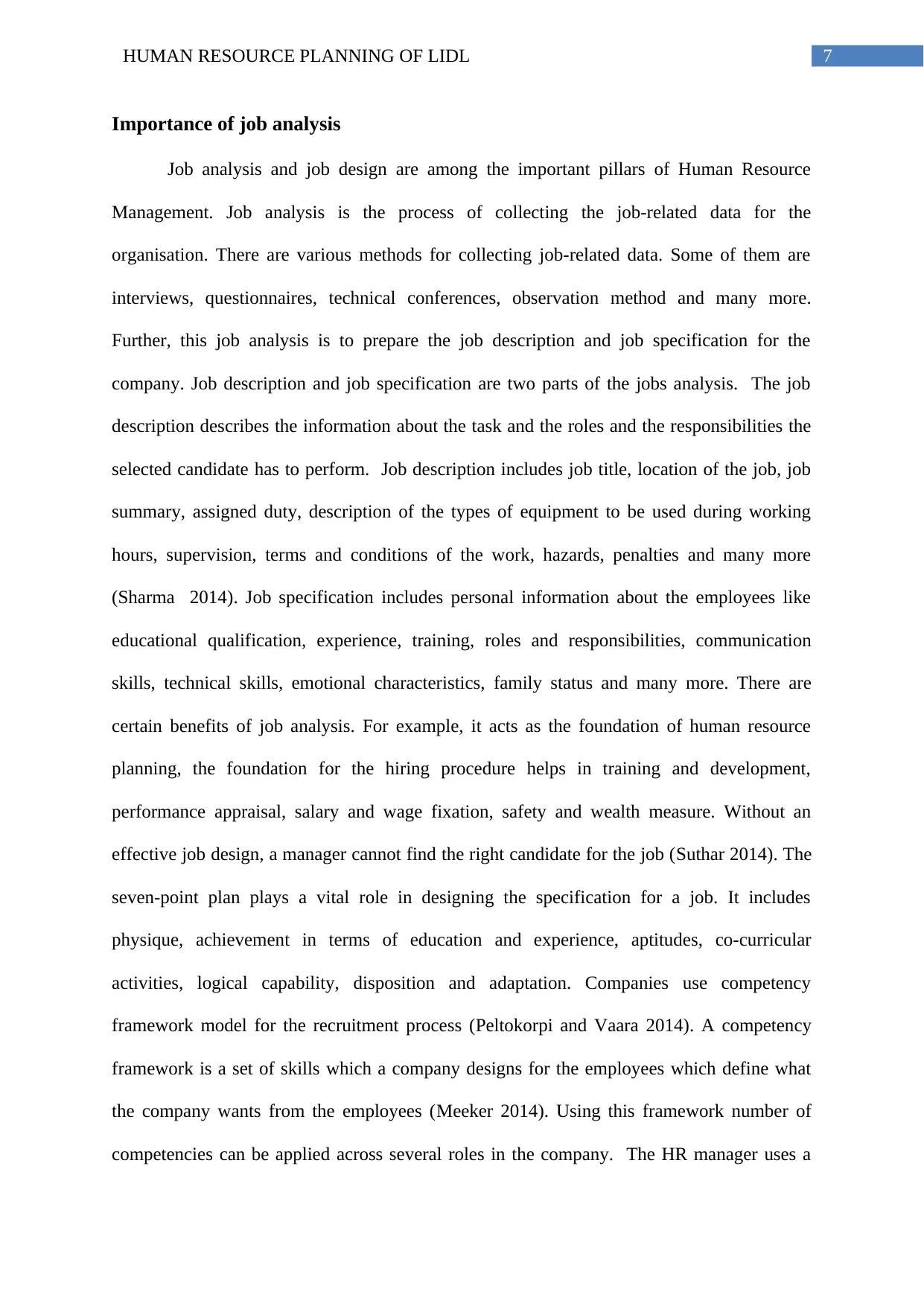
7HUMAN RESOURCE PLANNING OF LIDL
Importance of job analysis
Job analysis and job design are among the important pillars of Human Resource
Management. Job analysis is the process of collecting the job-related data for the
organisation. There are various methods for collecting job-related data. Some of them are
interviews, questionnaires, technical conferences, observation method and many more.
Further, this job analysis is to prepare the job description and job specification for the
company. Job description and job specification are two parts of the jobs analysis. The job
description describes the information about the task and the roles and the responsibilities the
selected candidate has to perform. Job description includes job title, location of the job, job
summary, assigned duty, description of the types of equipment to be used during working
hours, supervision, terms and conditions of the work, hazards, penalties and many more
(Sharma 2014). Job specification includes personal information about the employees like
educational qualification, experience, training, roles and responsibilities, communication
skills, technical skills, emotional characteristics, family status and many more. There are
certain benefits of job analysis. For example, it acts as the foundation of human resource
planning, the foundation for the hiring procedure helps in training and development,
performance appraisal, salary and wage fixation, safety and wealth measure. Without an
effective job design, a manager cannot find the right candidate for the job (Suthar 2014). The
seven-point plan plays a vital role in designing the specification for a job. It includes
physique, achievement in terms of education and experience, aptitudes, co-curricular
activities, logical capability, disposition and adaptation. Companies use competency
framework model for the recruitment process (Peltokorpi and Vaara 2014). A competency
framework is a set of skills which a company designs for the employees which define what
the company wants from the employees (Meeker 2014). Using this framework number of
competencies can be applied across several roles in the company. The HR manager uses a
Importance of job analysis
Job analysis and job design are among the important pillars of Human Resource
Management. Job analysis is the process of collecting the job-related data for the
organisation. There are various methods for collecting job-related data. Some of them are
interviews, questionnaires, technical conferences, observation method and many more.
Further, this job analysis is to prepare the job description and job specification for the
company. Job description and job specification are two parts of the jobs analysis. The job
description describes the information about the task and the roles and the responsibilities the
selected candidate has to perform. Job description includes job title, location of the job, job
summary, assigned duty, description of the types of equipment to be used during working
hours, supervision, terms and conditions of the work, hazards, penalties and many more
(Sharma 2014). Job specification includes personal information about the employees like
educational qualification, experience, training, roles and responsibilities, communication
skills, technical skills, emotional characteristics, family status and many more. There are
certain benefits of job analysis. For example, it acts as the foundation of human resource
planning, the foundation for the hiring procedure helps in training and development,
performance appraisal, salary and wage fixation, safety and wealth measure. Without an
effective job design, a manager cannot find the right candidate for the job (Suthar 2014). The
seven-point plan plays a vital role in designing the specification for a job. It includes
physique, achievement in terms of education and experience, aptitudes, co-curricular
activities, logical capability, disposition and adaptation. Companies use competency
framework model for the recruitment process (Peltokorpi and Vaara 2014). A competency
framework is a set of skills which a company designs for the employees which define what
the company wants from the employees (Meeker 2014). Using this framework number of
competencies can be applied across several roles in the company. The HR manager uses a
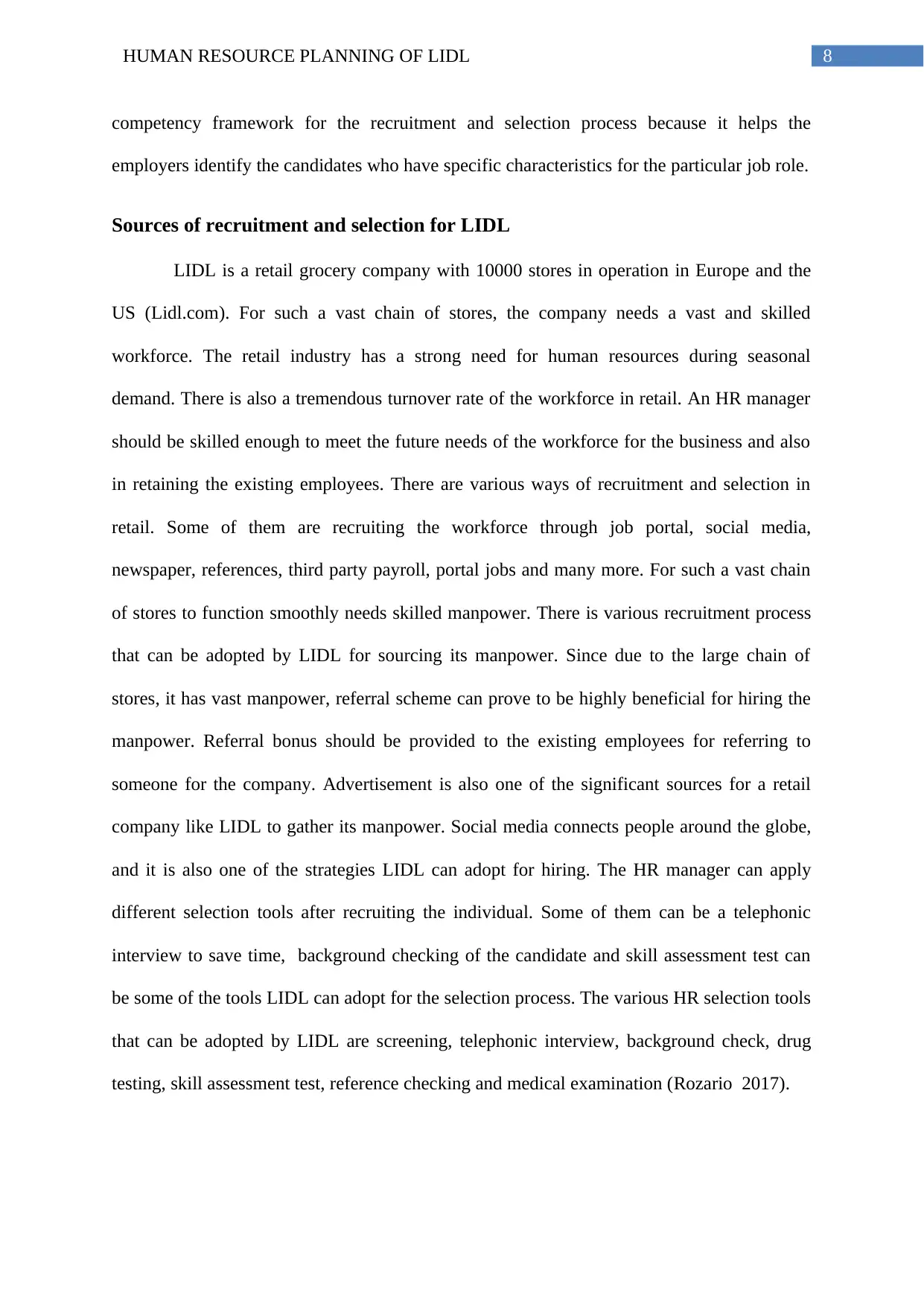
8HUMAN RESOURCE PLANNING OF LIDL
competency framework for the recruitment and selection process because it helps the
employers identify the candidates who have specific characteristics for the particular job role.
Sources of recruitment and selection for LIDL
LIDL is a retail grocery company with 10000 stores in operation in Europe and the
US (Lidl.com). For such a vast chain of stores, the company needs a vast and skilled
workforce. The retail industry has a strong need for human resources during seasonal
demand. There is also a tremendous turnover rate of the workforce in retail. An HR manager
should be skilled enough to meet the future needs of the workforce for the business and also
in retaining the existing employees. There are various ways of recruitment and selection in
retail. Some of them are recruiting the workforce through job portal, social media,
newspaper, references, third party payroll, portal jobs and many more. For such a vast chain
of stores to function smoothly needs skilled manpower. There is various recruitment process
that can be adopted by LIDL for sourcing its manpower. Since due to the large chain of
stores, it has vast manpower, referral scheme can prove to be highly beneficial for hiring the
manpower. Referral bonus should be provided to the existing employees for referring to
someone for the company. Advertisement is also one of the significant sources for a retail
company like LIDL to gather its manpower. Social media connects people around the globe,
and it is also one of the strategies LIDL can adopt for hiring. The HR manager can apply
different selection tools after recruiting the individual. Some of them can be a telephonic
interview to save time, background checking of the candidate and skill assessment test can
be some of the tools LIDL can adopt for the selection process. The various HR selection tools
that can be adopted by LIDL are screening, telephonic interview, background check, drug
testing, skill assessment test, reference checking and medical examination (Rozario 2017).
competency framework for the recruitment and selection process because it helps the
employers identify the candidates who have specific characteristics for the particular job role.
Sources of recruitment and selection for LIDL
LIDL is a retail grocery company with 10000 stores in operation in Europe and the
US (Lidl.com). For such a vast chain of stores, the company needs a vast and skilled
workforce. The retail industry has a strong need for human resources during seasonal
demand. There is also a tremendous turnover rate of the workforce in retail. An HR manager
should be skilled enough to meet the future needs of the workforce for the business and also
in retaining the existing employees. There are various ways of recruitment and selection in
retail. Some of them are recruiting the workforce through job portal, social media,
newspaper, references, third party payroll, portal jobs and many more. For such a vast chain
of stores to function smoothly needs skilled manpower. There is various recruitment process
that can be adopted by LIDL for sourcing its manpower. Since due to the large chain of
stores, it has vast manpower, referral scheme can prove to be highly beneficial for hiring the
manpower. Referral bonus should be provided to the existing employees for referring to
someone for the company. Advertisement is also one of the significant sources for a retail
company like LIDL to gather its manpower. Social media connects people around the globe,
and it is also one of the strategies LIDL can adopt for hiring. The HR manager can apply
different selection tools after recruiting the individual. Some of them can be a telephonic
interview to save time, background checking of the candidate and skill assessment test can
be some of the tools LIDL can adopt for the selection process. The various HR selection tools
that can be adopted by LIDL are screening, telephonic interview, background check, drug
testing, skill assessment test, reference checking and medical examination (Rozario 2017).
⊘ This is a preview!⊘
Do you want full access?
Subscribe today to unlock all pages.

Trusted by 1+ million students worldwide
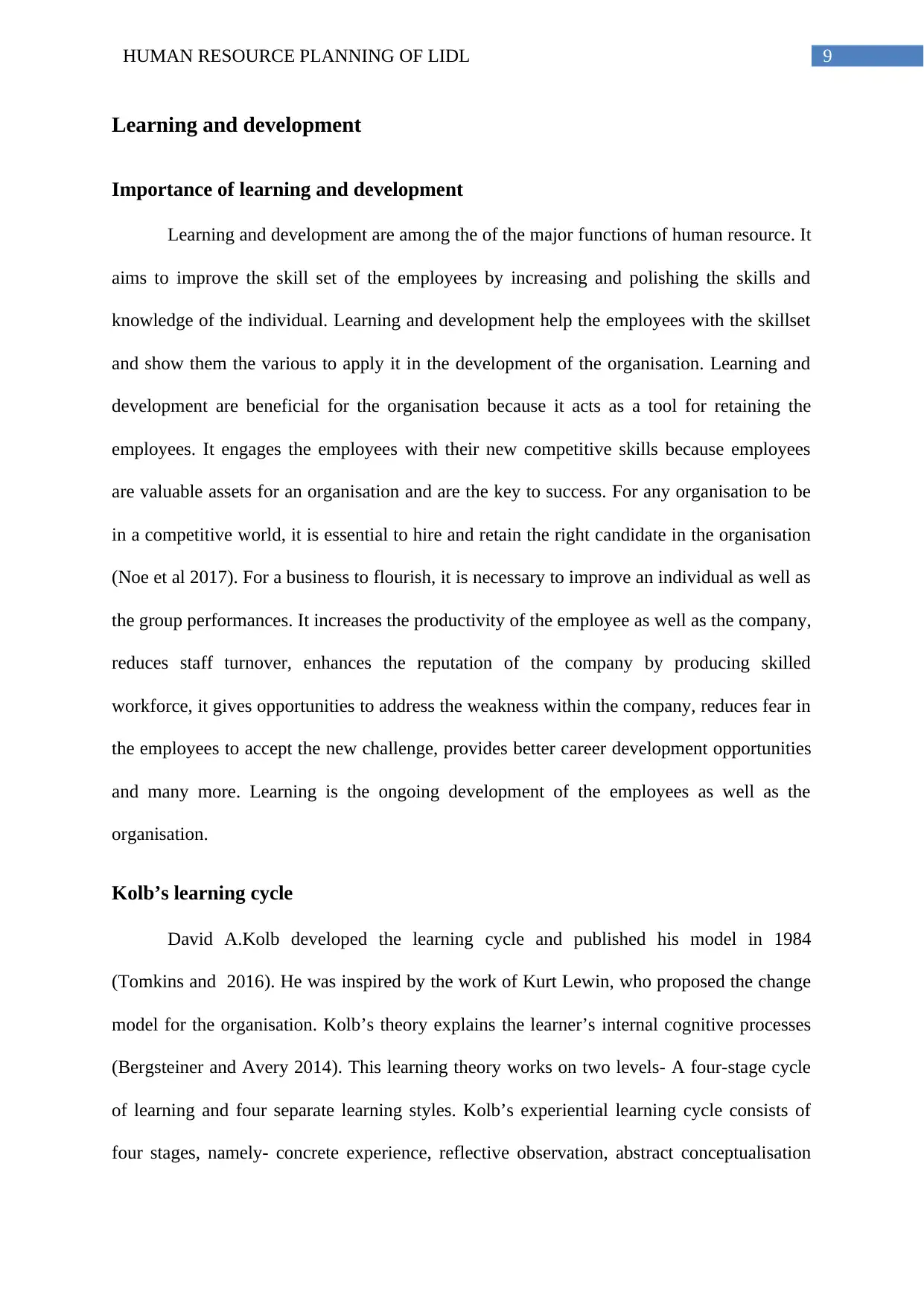
9HUMAN RESOURCE PLANNING OF LIDL
Learning and development
Importance of learning and development
Learning and development are among the of the major functions of human resource. It
aims to improve the skill set of the employees by increasing and polishing the skills and
knowledge of the individual. Learning and development help the employees with the skillset
and show them the various to apply it in the development of the organisation. Learning and
development are beneficial for the organisation because it acts as a tool for retaining the
employees. It engages the employees with their new competitive skills because employees
are valuable assets for an organisation and are the key to success. For any organisation to be
in a competitive world, it is essential to hire and retain the right candidate in the organisation
(Noe et al 2017). For a business to flourish, it is necessary to improve an individual as well as
the group performances. It increases the productivity of the employee as well as the company,
reduces staff turnover, enhances the reputation of the company by producing skilled
workforce, it gives opportunities to address the weakness within the company, reduces fear in
the employees to accept the new challenge, provides better career development opportunities
and many more. Learning is the ongoing development of the employees as well as the
organisation.
Kolb’s learning cycle
David A.Kolb developed the learning cycle and published his model in 1984
(Tomkins and 2016). He was inspired by the work of Kurt Lewin, who proposed the change
model for the organisation. Kolb’s theory explains the learner’s internal cognitive processes
(Bergsteiner and Avery 2014). This learning theory works on two levels- A four-stage cycle
of learning and four separate learning styles. Kolb’s experiential learning cycle consists of
four stages, namely- concrete experience, reflective observation, abstract conceptualisation
Learning and development
Importance of learning and development
Learning and development are among the of the major functions of human resource. It
aims to improve the skill set of the employees by increasing and polishing the skills and
knowledge of the individual. Learning and development help the employees with the skillset
and show them the various to apply it in the development of the organisation. Learning and
development are beneficial for the organisation because it acts as a tool for retaining the
employees. It engages the employees with their new competitive skills because employees
are valuable assets for an organisation and are the key to success. For any organisation to be
in a competitive world, it is essential to hire and retain the right candidate in the organisation
(Noe et al 2017). For a business to flourish, it is necessary to improve an individual as well as
the group performances. It increases the productivity of the employee as well as the company,
reduces staff turnover, enhances the reputation of the company by producing skilled
workforce, it gives opportunities to address the weakness within the company, reduces fear in
the employees to accept the new challenge, provides better career development opportunities
and many more. Learning is the ongoing development of the employees as well as the
organisation.
Kolb’s learning cycle
David A.Kolb developed the learning cycle and published his model in 1984
(Tomkins and 2016). He was inspired by the work of Kurt Lewin, who proposed the change
model for the organisation. Kolb’s theory explains the learner’s internal cognitive processes
(Bergsteiner and Avery 2014). This learning theory works on two levels- A four-stage cycle
of learning and four separate learning styles. Kolb’s experiential learning cycle consists of
four stages, namely- concrete experience, reflective observation, abstract conceptualisation
Paraphrase This Document
Need a fresh take? Get an instant paraphrase of this document with our AI Paraphraser
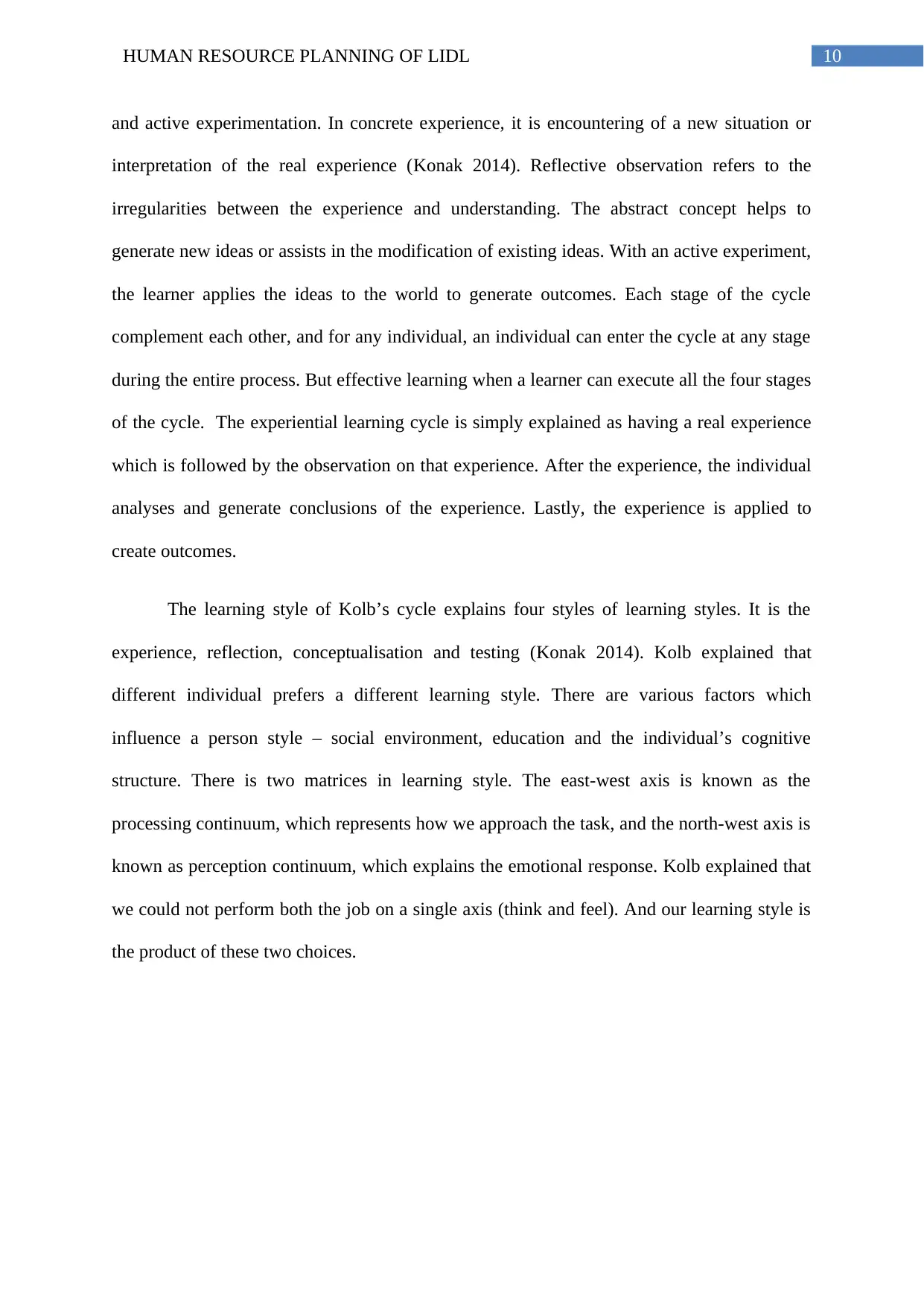
10HUMAN RESOURCE PLANNING OF LIDL
and active experimentation. In concrete experience, it is encountering of a new situation or
interpretation of the real experience (Konak 2014). Reflective observation refers to the
irregularities between the experience and understanding. The abstract concept helps to
generate new ideas or assists in the modification of existing ideas. With an active experiment,
the learner applies the ideas to the world to generate outcomes. Each stage of the cycle
complement each other, and for any individual, an individual can enter the cycle at any stage
during the entire process. But effective learning when a learner can execute all the four stages
of the cycle. The experiential learning cycle is simply explained as having a real experience
which is followed by the observation on that experience. After the experience, the individual
analyses and generate conclusions of the experience. Lastly, the experience is applied to
create outcomes.
The learning style of Kolb’s cycle explains four styles of learning styles. It is the
experience, reflection, conceptualisation and testing (Konak 2014). Kolb explained that
different individual prefers a different learning style. There are various factors which
influence a person style – social environment, education and the individual’s cognitive
structure. There is two matrices in learning style. The east-west axis is known as the
processing continuum, which represents how we approach the task, and the north-west axis is
known as perception continuum, which explains the emotional response. Kolb explained that
we could not perform both the job on a single axis (think and feel). And our learning style is
the product of these two choices.
and active experimentation. In concrete experience, it is encountering of a new situation or
interpretation of the real experience (Konak 2014). Reflective observation refers to the
irregularities between the experience and understanding. The abstract concept helps to
generate new ideas or assists in the modification of existing ideas. With an active experiment,
the learner applies the ideas to the world to generate outcomes. Each stage of the cycle
complement each other, and for any individual, an individual can enter the cycle at any stage
during the entire process. But effective learning when a learner can execute all the four stages
of the cycle. The experiential learning cycle is simply explained as having a real experience
which is followed by the observation on that experience. After the experience, the individual
analyses and generate conclusions of the experience. Lastly, the experience is applied to
create outcomes.
The learning style of Kolb’s cycle explains four styles of learning styles. It is the
experience, reflection, conceptualisation and testing (Konak 2014). Kolb explained that
different individual prefers a different learning style. There are various factors which
influence a person style – social environment, education and the individual’s cognitive
structure. There is two matrices in learning style. The east-west axis is known as the
processing continuum, which represents how we approach the task, and the north-west axis is
known as perception continuum, which explains the emotional response. Kolb explained that
we could not perform both the job on a single axis (think and feel). And our learning style is
the product of these two choices.
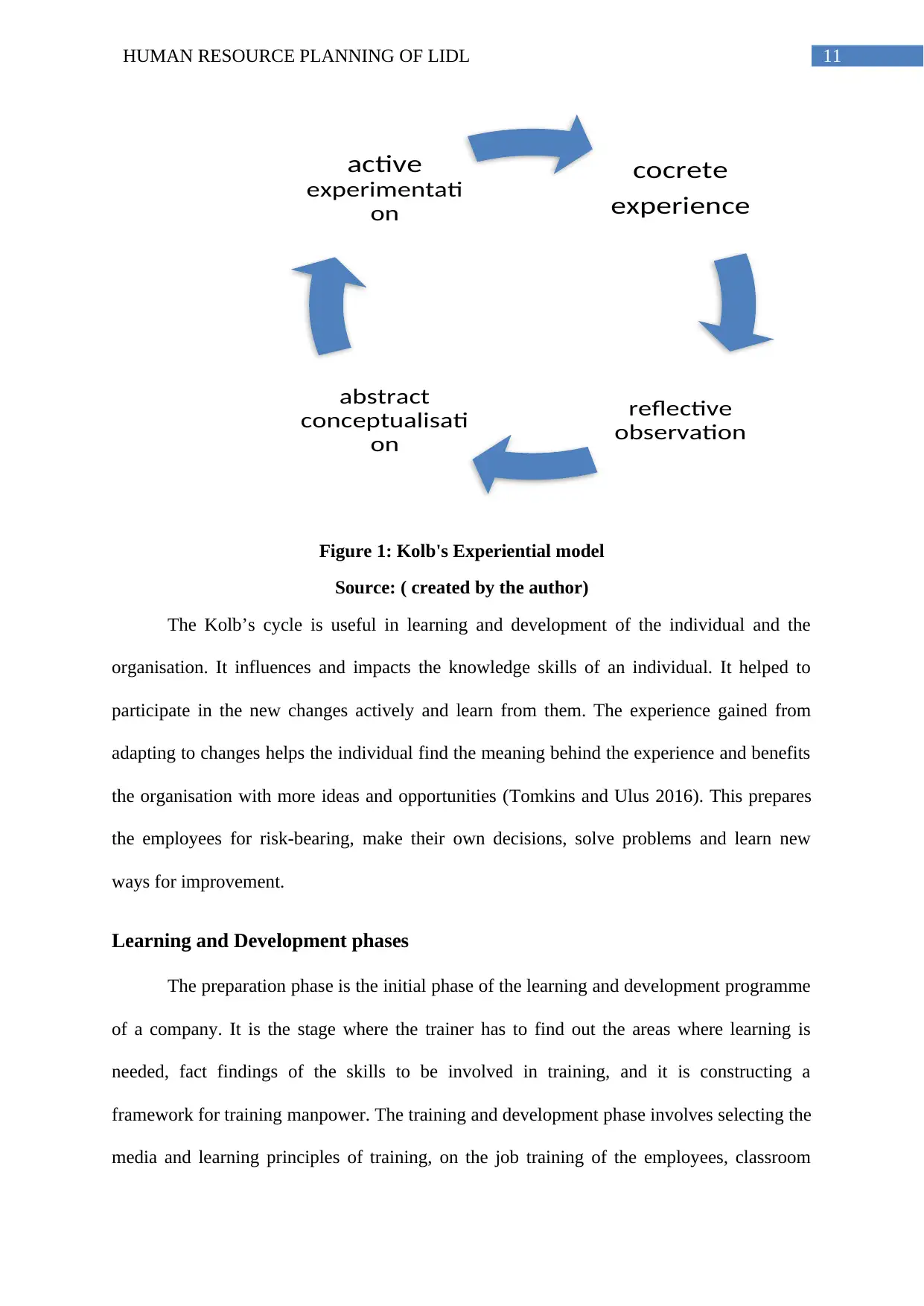
11HUMAN RESOURCE PLANNING OF LIDL
Figure 1: Kolb's Experiential model
Source: ( created by the author)
The Kolb’s cycle is useful in learning and development of the individual and the
organisation. It influences and impacts the knowledge skills of an individual. It helped to
participate in the new changes actively and learn from them. The experience gained from
adapting to changes helps the individual find the meaning behind the experience and benefits
the organisation with more ideas and opportunities (Tomkins and Ulus 2016). This prepares
the employees for risk-bearing, make their own decisions, solve problems and learn new
ways for improvement.
Learning and Development phases
The preparation phase is the initial phase of the learning and development programme
of a company. It is the stage where the trainer has to find out the areas where learning is
needed, fact findings of the skills to be involved in training, and it is constructing a
framework for training manpower. The training and development phase involves selecting the
media and learning principles of training, on the job training of the employees, classroom
cocrete
experience
reflective
observation
abstract
conceptualisati
on
active
experimentati
on
Figure 1: Kolb's Experiential model
Source: ( created by the author)
The Kolb’s cycle is useful in learning and development of the individual and the
organisation. It influences and impacts the knowledge skills of an individual. It helped to
participate in the new changes actively and learn from them. The experience gained from
adapting to changes helps the individual find the meaning behind the experience and benefits
the organisation with more ideas and opportunities (Tomkins and Ulus 2016). This prepares
the employees for risk-bearing, make their own decisions, solve problems and learn new
ways for improvement.
Learning and Development phases
The preparation phase is the initial phase of the learning and development programme
of a company. It is the stage where the trainer has to find out the areas where learning is
needed, fact findings of the skills to be involved in training, and it is constructing a
framework for training manpower. The training and development phase involves selecting the
media and learning principles of training, on the job training of the employees, classroom
cocrete
experience
reflective
observation
abstract
conceptualisati
on
active
experimentati
on
⊘ This is a preview!⊘
Do you want full access?
Subscribe today to unlock all pages.

Trusted by 1+ million students worldwide
1 out of 18
Related Documents
Your All-in-One AI-Powered Toolkit for Academic Success.
+13062052269
info@desklib.com
Available 24*7 on WhatsApp / Email
![[object Object]](/_next/static/media/star-bottom.7253800d.svg)
Unlock your academic potential
Copyright © 2020–2025 A2Z Services. All Rights Reserved. Developed and managed by ZUCOL.




